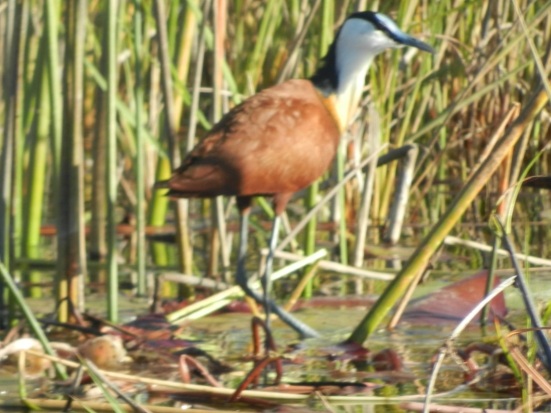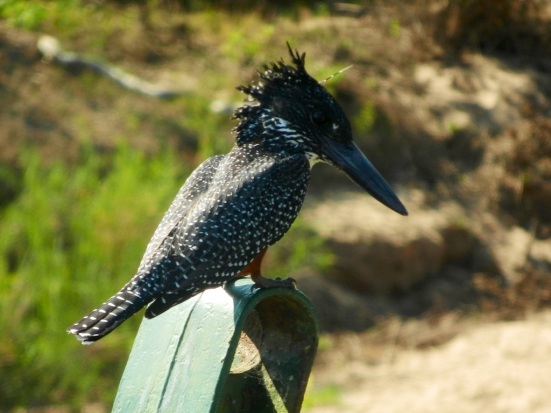When I wrote my first all-birds post a few months ago, I was still resisting labeling myself a full-fledged bird person. Bird-watchers don’t exactly have a rep for being people you want to hang out with.
I think it was a Lilac Breasted Roller, the national bird of Botswana, that pushed me over the edge. You can probably see why just from looking at it.
I haven’t yet reached the level of photographic prowess required to capture it in flight, but someone else who posts photos on the internet has, so thanks to that person and google images you can see here that its colors are even more amazing when it spreads its wings.
Not many birds can compete with the Lilac Breasted Roller in the looks department, but all over Botswana I saw birds exhibiting a range of colors that I never knew existed in the wild. These are the ones I managed to get on film (well, technically on my memory card): a Golden Weaver (and I thought yellow grass made me think of Rumpelstiltskin!), a Crimson Breasted Shrike, a Common Bulbul, and a Glossy Starling.
Of course, even a bird lover has to admit that not every bird is beautiful. The Yellow Billed Hornbill isn’t exactly ugly either, just kind of funny-looking.
Look familiar? He’s the inspiration for Zazu, the trusted-but-uptight advisor / babysitter in The Lion King.
Zazu: I think it’s time that you and I arranged a heart-to-heart.
Simba: Kings don’t need advice from little Hornbills for a start.
These next two species aren’t quite pretty either, but I definitely wouldn’t call them funny-looking. Majestic, maybe?
Pied Crows preening by Lake Bunyoni in Uganda.
The African Fish Eagle — national bird of Zambia and Zimbabwe; makes an appearance on the coats of arms of Namibia and South Sudan; bears a strong family resemblance to the Bald Eagle; has an impressive six-foot wingspan.
The African Fish Eagle is a predatory bird that feeds mostly on (surprise!) fish, but will also eat small mammals and baby crocodiles if it has the chance. The Eagle has excellent vision and can spot fish swimming in the water from a perch on top of a tree. This video almost shows an African Fish Eagle scooping a fish out of Lake Naivasha.
So close! My consolation prize was catching it in this photo, flying away with the fish clasped in its talons.
Towards the other end of the size spectrum, this dainty little thing is an African Jacana. The African Jacana is also known as a Lily-Hopper, because it walks on lily pads, or a Jesus Bird, because it looks like it’s walking on water. It owes its ability to perform that miracle to its light weight and long toes, which help it distribute that weight so as not to sink the lily pads. This photo is from the Okavango Delta, where African Jacanas are one of the most common birds.
These next three are larger wading birds: a Yellow Billed Stork at Lake Nakuru (Kenya), a Snowy Egret on the Nile in Jinja (Uganda) and two African Sacred Ibises, also on the Nile. I love their white feathers with splashes of color mixed in.
And to wrap up this post, here’s a glimpse into the Kingfisher family, which is another one of my favorites. Like Fish Eagles, Kingfishers are hunters who primarily eat fish but will also occasionally seek out other forms of prey, including insects, reptiles, and small mammals. Also like a Fish Eagle, a Kingfisher will spot its prey from a high perch. Then you’ll see it fly over the water and suddenly stop, flapping its wings furiously as if it’s treading air, before diving down to grab a fish.
The next two photos are of a Giant Kingfisher (the largest of the family, as you could probably guess from its name) and a Pied Kingfisher (yes, just like the Pied Crow — fyi, the OED defines Pied as “having two or more colors,” but as far as I can tell, in bird taxonomy it means “black and white.”).
Finally, the star of the Kingfisher family: the Malachite Kingfisher. This photo does not do it justice at all, but hopefully you can still get a sense of how bright and beautiful it is. It’s pretty tiny (although the aptly-named Dwarf and Pygmy Kingfishers are tinier) and very shy, so getting close enough for a good photo is a challenge — this is the best I could do after many tries with many different Malachites in many different countries.
For the record, the Woodland Kingfisher is also pretty gorgeous, but I’ve only ever seen one or two and never had my camera out at the right moment. There are also a number of beautiful Kingfisher species outside of Africa. A few examples (courtesy of google images):
So, anyone ready yet to join me on a birdwatching trip with a group of gray beards and giant binoculars? Bueller?























really beautiful birds… I cannot wait to get to Africa some time please G-d.
Thanks for sharing and making it feel like we are in Africa experiencing all this beauty.
Love, Mom xxoo
Thanks for keeping on commenting 🙂 xo
I’m ready to join you on a birdwatching trip ! The birds are all so beautiful. You’re right in that the Lilac Breasted Roller is absolutely gorgeous and looks even more soin flight ! That picture of the African Fish Eagle with the fish in its talons is quite amazing !
It is so great that you post these wonderful experiences; I just love to see these posts and I feel that I’m very much a part of it, just like your Mom says !
Thanks Elana darling; love Sim.
Thanks Sim, it’s so much fun to share all of this and I always love your comments!
Love the majestic colors and the spot on reporting…
Plus I already have the Beard & Bino’s…. ;^)
You are ready!! 🙂 Maybe we can start in NJ!
Beautiful pictures Elana
Love Elsie xx